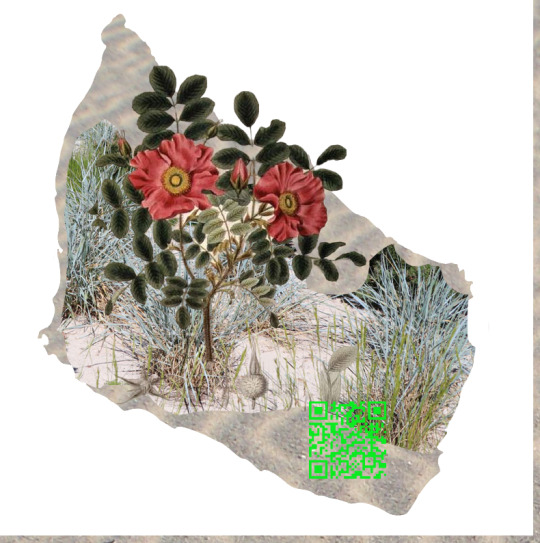#nikimatita
Text
ENGLISH below
Begleittext zur Installation
Niki Matita ::: Rugini
Die größte dänische Insel Bornholm liegt näher an der größten deutschen (Ostsee)Insel Rügen als an ihrer Landeshauptstadt Kopenhagen. Umgerechnet baut Dänemark 116,5kg und Deutschland 37kg Roggen pro Einwohner*in an. Damit sind die beiden Nachbarstaaten unter den fünf größten Anbauländern weltweit.
Über 1200 Jahre war Roggen synonym mit dem Korn, also dem Hauptnahrungsmittel, der Brotfrucht. Der Name der Insel Rügen (lat. Rugia) geht auf dieses Getreide zurück.
Die Rugini (auch Ranen, Rujanen, Ruani) waren ein westslawisches Volk auf den Inseln Rügen, Bornholm und dem umliegenden Festland. Der Name des Stammes bezieht sich auf den Roggenanbau, der bis heute typisch für den Baltischen Raum ist. Wenig ist von ihrer Sprache, ihrer Musik und ihren Bräuchen überliefert, doch gibt es in den folkloristischen Künsten international einige, auch erotische, Bezüge zu dieser Feldfrucht, die bis weit ins Mittelalter reichen.
Fürst Wizlaw von Rügen und seine große Liebe, Fürstin Margarete, machen eine Reise. Über einen rutschigen Steg gelangen sie auf das Schiff, ein Geistlicher hilft ihnen dabei. Das Wasser des Meeres ist kalt, tief und salzig. Die Leute tragen schon warme Mäntel, denn das Wetter ist kalt. Auch der König der Dänen und Slawen, Erik Menved, ist auf dem Schiff. Er trägt eine goldene Krone. Zwei Knappen aus der Heerschar, Satko zu Saatel und der wendische Vyriz, blasen fröhlich auf langen Fanfaren.
*Eine Ruginiliebesgeschichte, überliefert aus dem Polabischen - welches der Sprache der Rugini, dem Ranischen, ähnlich sein soll
--------------------------------------------------------------------------
ENGLISH
Liner notes to the installation
Rugini by Niki Matita
The largest Danish island Bornholm is closer to the largest German (Baltic Sea) island Rügen than it is to its capital Copenhagen. This means that Denmark grows 116.5kg and Germany 37kg of rye per inhabitant. That puts these two countries in the top five largest rye-growing countries in the world.
For over 1200 years, rye was synonymous with grain, i.e. the staple food, the breadfruit. The name of the island of Rügen (lat. Rugia) goes back to this grain.
The Rugini (also Ranen, Rujanen, Ruani) were a West Slavic people on the islands of Rügen, Bornholm and the surrounding mainland. The tribe's name refers to the practice of growing rye, which is still typical of the Baltic region today. Little has survived of their language, their music and their customs, but there are some references to this crop, including erotic ones, in the folkloric arts around the world, which date back well into the Middle Ages.
Prince Wizlaw of Rügen and his great love, Princess Margarete, go on a journey. They get onto the ship via a slippery footbridge, helped by a clergyman. The sea water is cold, deep and salty. The people are already wearing warm coats because the weather is cold. The King of the Danes and Slavs, Erik Menved, is also on the ship. He is wearing a golden crown. Two squires from the army, Satko zu Saatel and the Wendish Vyriz, are happily blowing long fanfares.
A story about Rugini lovers, passed on in Polabian - which is said to be similar to the language of the Rugini, Rani
#rügen#bornholm#ranen#rugini#sound art#radio art#installation#insel#nikimatita#minimatika#berlin#kleingartenanlage bornholm i#Korobeiniki#Robert Burns#Secale cereale#Roggen#rye#love#liebe#Nikolai Alexejewitsch Nekrassow
2 notes
·
View notes
Text
#sound art#installation#insel#©niki_matita#nikimatita#minimatika#kleingartenanlage bornholm i#bornholm#rügen#roggen#rye
0 notes
Text

Entwurf // Sketch
Niki Matita ::: RUGINI
#klangkunst#soundart#nikimatita#pankow#insel#island#prenzlauerberg#radio art#bornholm#rügen#kunst#artwalk#art walk
0 notes